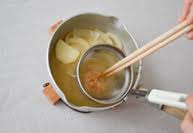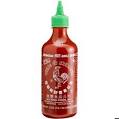Basics:
 |
| Soy Sauce |
- Soy Sauce
Common Asian Pantry Items!
Common Asian Pastes/Sauces:
- Dou-Ban-Jiang (Chinesen Fermented Bean Paste) -豆瓣酱

Dou-Ban-Jiang - It is a spicy, salty paste made from fermented broad beans, soybeans, salt, rice, and various spices.
- Dou-ban-jiang exists in plain and spicy versions that you can find in the Asian grocery market, with the latter containing red chili peppers and called La Doubanjiang (辣豆瓣酱, meaning hot fermented bean paste). I usually get the plain version and adjust my heat level with additional hot chili agent.
- The sauce is used as a flavoring agent usually in the beginning of cooking process to build a more complex flavor base, employing the umami from the fermentation of bean protein. It is not a premix sauce to be used as a table condiment and can taste too harsh, too tense without the heating/blooming process.
- This sauce is very versatile that I would suggest this is the first ethnic item that you can add to your pantry. It can be used in stir-fry, braise or stew dishes and is good with meat, seafood, tofu, rice, noodle.
- In Korean cuisine, a similar form of bean paste is called doenjang.
- Fish Sauce -
- Made by fermenting small fish, such as anchovies, for a few days and layering the fish into a barrel with salt in between each layers. The barrels sit in the sun for about nine month and the liquid found in the barrel at the end of time is fish sauce. The process not only capture the protein in small fish but also create a savory flavor (umami) from the fermentation of fish protein.
- It smells like bait and is commonly used in Korea and Southeast Asia, where the small fish are readily available and abundant.
- Hoisin Sauce -海鮮醬
- It is a thick, pungent sauce commonly used in Chinese cuisine as a glaze for meat, an flavoring agent to stir fries, as dipping sauce, or as a table condiment in all kinds of meat, poultry and fish dishes. For example, it is used on a Peking duck wrap.
- It is darkly colored in appearance and sweet and salty in taste.
- The most common ingredients include sugar, soybeans, vinegar, salt, flour, and chile peppers. It could also contain Chinese five spices, wheat or rice, garlic among others.
- The word hoisin is from the Chinese word for seafood (海鮮) but the sauce does not contain any seafood ingredients.
- Miso (Japanese Fermented Bean Paste) -
-
A traditional Japanese seasoning produced by fermenting rice, barley, and/or soybeans with salt and the fungus kōjikin (麹菌), the most typical miso being made with soy. The result is a thick paste used for sauces and spreads, pickling vegetables or meats, and mixing with dashi soup stock to serve as miso soup called miso-shiru (味噌汁), a Japanese culinary staple.
- When using miso paste, you need to thin it out with water before adding into the dish or use it as a marinade, as it is quite thick.
- When use it in miso-shiru, you add the miso paste last, and either you have already thinned it out or you'll have to dissolve it through a strainer quickly. Turn the heat off as soon as it comes back to a boil. Boiling miso paste for long will eliminate the subtle miso flavor and all you have left would be just the saltiness at the end.
- Oyster Sauce -
-
Oyster sauce is a thick, dark brown sauce beloved in Chinese and Thai cuisine. As its name implies it is made from oysters, as well as brine and soy sauce. When purchasing oyster sauce make sure to read the ingredient list on the label. As with all products, the ingredients are listed in descending order by weight.
-
Traditionally, oyster sauce is made by slowly simmering oysters in water until the juices caramelize into a thick, brown, intensely flavorful sauce. Today, many shortcuts have been made to create a similar flavor more quickly and at reduced cost.
 While quality oyster sauces are primarily oysters, others are usually made with a base of sugar and salt and thickened with corn starch. Oyster extracts or essences are then used to give flavour to the base sauce. Other ingredients, such as soy sauce and MSG may also be added to deepen the flavour and add colour. The quality of the oyster sauce will greatly affect the flavour.
While quality oyster sauces are primarily oysters, others are usually made with a base of sugar and salt and thickened with corn starch. Oyster extracts or essences are then used to give flavour to the base sauce. Other ingredients, such as soy sauce and MSG may also be added to deepen the flavour and add colour. The quality of the oyster sauce will greatly affect the flavour. - Oyster sauce imparts a rich and savory dimension to food. While it can serve as a condiment, it is more likely utilized as a flavoring component of stir fries, noodle dishes and marinades. It can also be used in stewed or braised meat dishes.
- Sambal Hot Chili Sauce
-
It is a hot sauce typically made from a mixture of variety of chili peppers with secondary ingredients such as shrimp paste, fish sauce, garlic, ginger, shallot, scallion, palm sugar, lime juice, and rice vinegar or other vinegars. Sambal is an Indonesian loan-word of Javanese origin (sambel).
- Sriracha Sauce
-
 It is a hot and very spicy chile based sauces widely popular throughout Southeast Asia. The chiles that form the base of these sauces run the gamut and include Thai chiles, cayenne, jalapenos, habaneros and countless other varieties. Then, vinegar, garlic, salt, sugar, citrus juices, you name it, are included.
It is a hot and very spicy chile based sauces widely popular throughout Southeast Asia. The chiles that form the base of these sauces run the gamut and include Thai chiles, cayenne, jalapenos, habaneros and countless other varieties. Then, vinegar, garlic, salt, sugar, citrus juices, you name it, are included. - Sriracha and Sambal function as both an ingredient and a condiment. While the sky is the limit in terms of uses, I am especially fond of these sauces slathered on duck, ribs or fried chicken wings.
- Tare 垂れ (Soy BBQ/Basting Sauce or Soy Dipping Sauce)
-
Tare is a general term in Japanese cuisine for basting or dipping sauces often used in grilling (unagi/eel, yakitori and yakiniku, especially as teriyaki sauce) as well as with sushi, nabemono and gyoza.
- The sauce is best described as sweetened, thickened soy sauce for grilling and flavored soy sauce with dashi, vinegar, etc., for nabemono and natto such as ponzu but every chef has their own variation.
- Tian-Mian-Jiang 甜麵醬 (Sweet Bean Paste or Sweet Flour Paste) -
- It is a thick, dark brown- or black-colored Chinese sauce made from wheat flour, sugar, salt, man-tou flour (milled wheat flour), and fermented yellow soybeans (the lees left over from the fermentation of soybeans to make soy sauce).
- In Korea, the sauce is made with a dark soybean paste. This paste, which is made from roasted soybeans and caramel, is called chunjang (literally "spring paste", hangul: 춘장; Chinese: 春醬)
- Tsu-yu つゆ (Soup Base) -
- Also called Men-Tsu-Yu (noodle soup base). It is a multi-purpose sauce for dipping, flavoring or seasoning and widely used in Japanese cooking.


Notes:
- Man-Tou 饅頭: Chinese Steamed Buns made from milled wheat flour in Northern part of China.






No comments :
Post a Comment